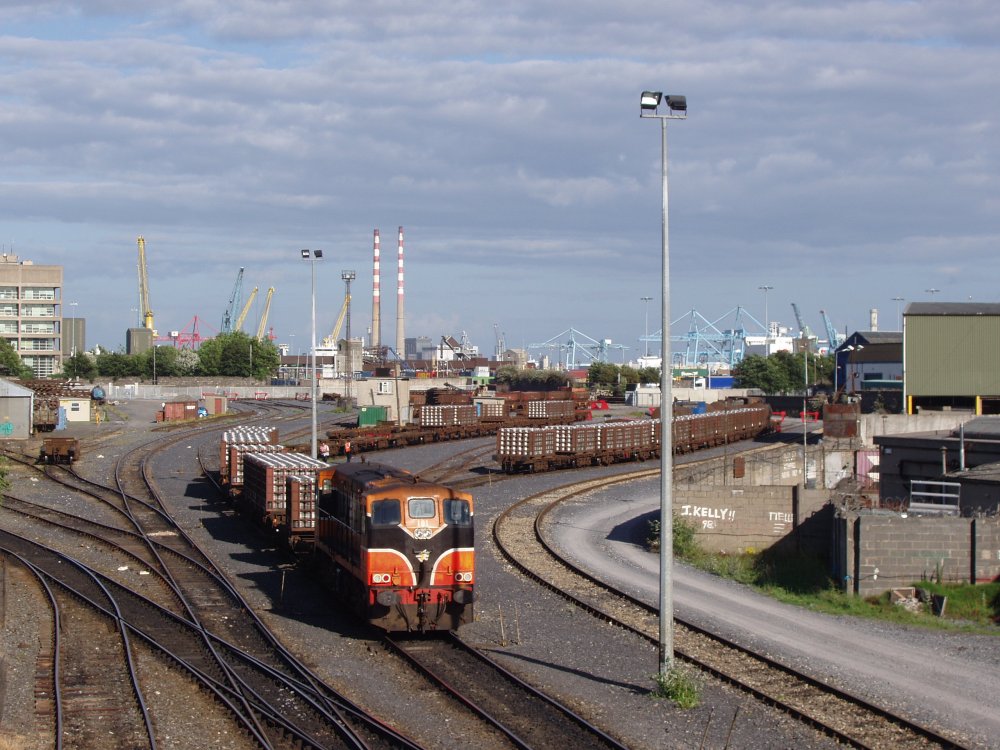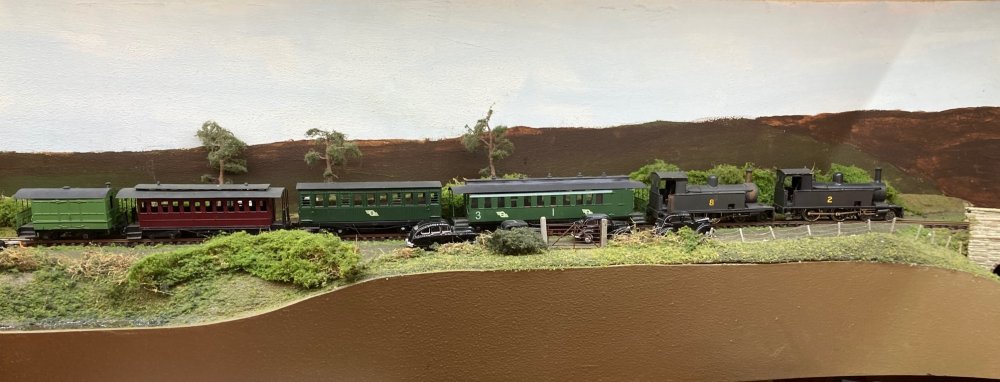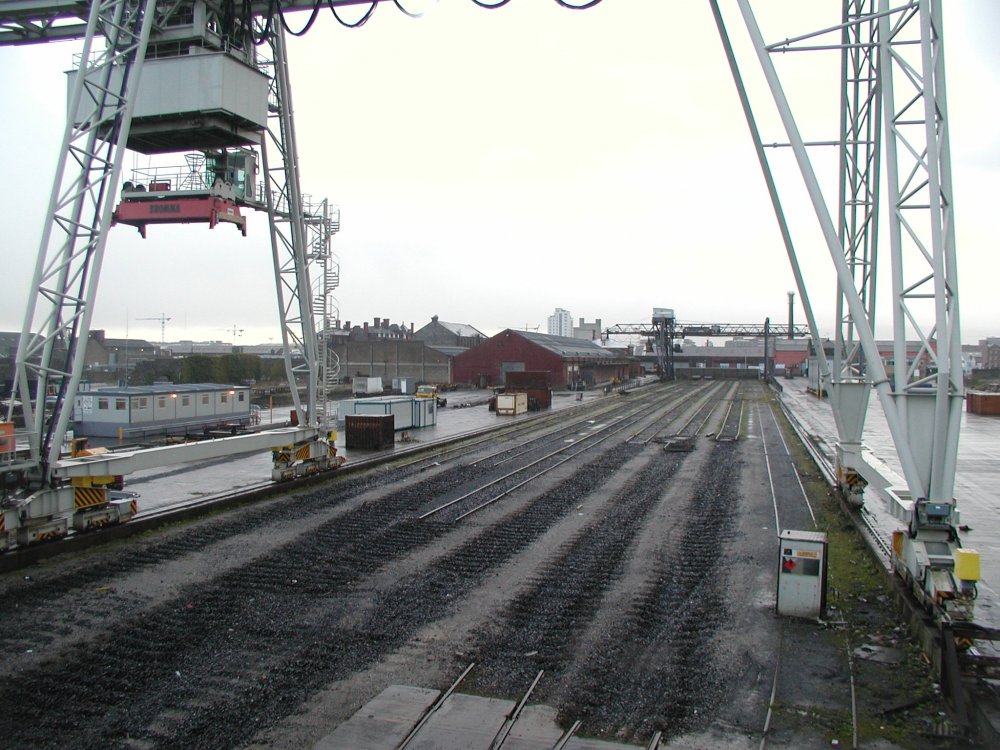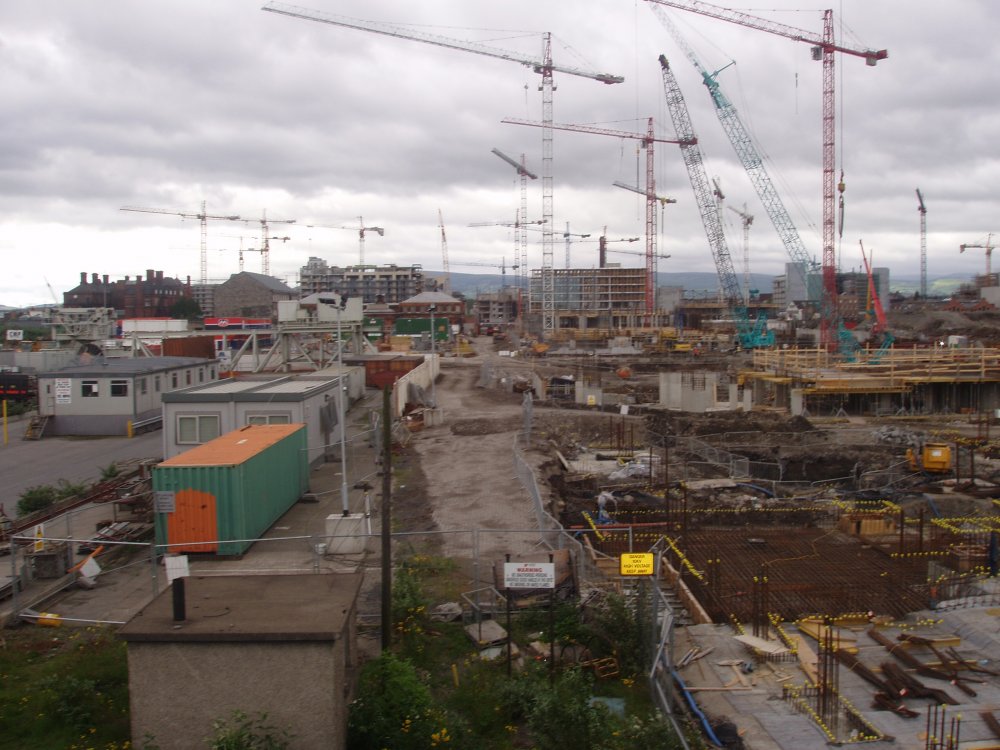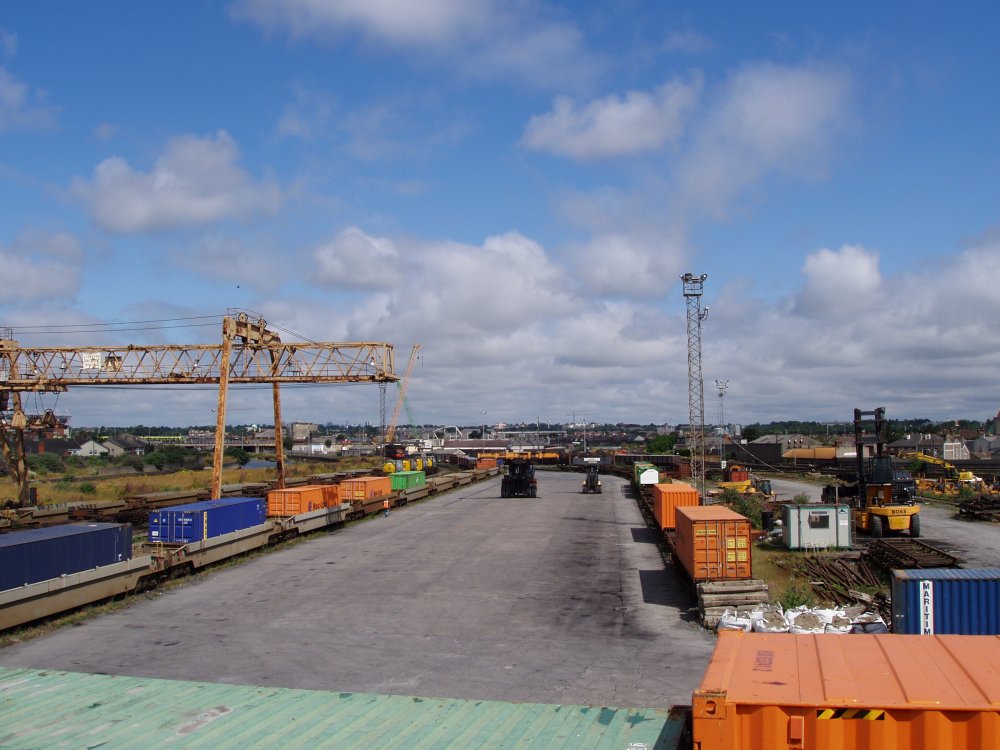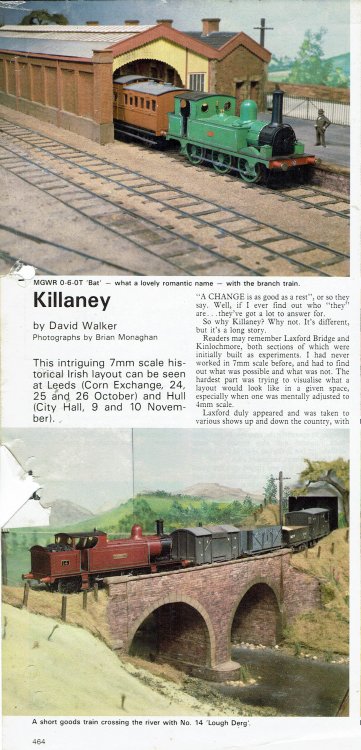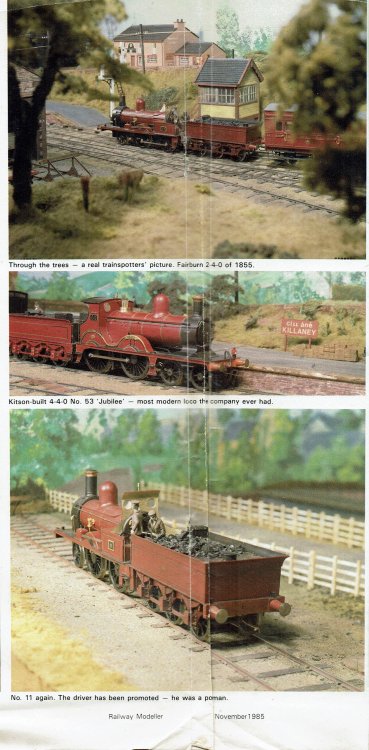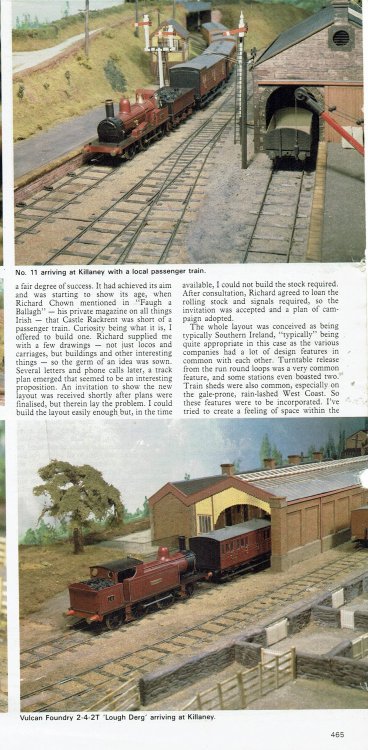-
Posts
4,858 -
Joined
-
Last visited
-
Days Won
119
Content Type
Profiles
Forums
Events
Gallery
Blogs
Store
Community Map
Everything posted by Mayner
-
The SLNCR always operated on a shoestring as it was not very profitable, the Midland & GNR considered taking over the line in the late 19th Century, but it continued to operate as an independent company because of opposition to MGWR involvement by Sligo merchant interests. The lined depended on "Grant in Aid" from Stormont to make up its operating losses following partition which would have left very little for renewals, line made a small profit during the Emergency/WW11 which appears to have paid for the railcar. The SLNCR ordered Lough Erne and Lough Melvin because no suitable second hand locos were available, the locos were eventually delivered after the Northern Ireland Government paid 2/3 of the initial £3,000 hire purchase installment. Stormont cut back its grant in aid to £1,500 a year in the early 1950s with the balance of the losses made up of payments from the GNR and surcharges on cattle shipments which would not have helped traffic. In a way the SLNCR was like a person in poor health who lived a long and eventful life and almost outlived a strong and healthy relative or friend as its demise came about as a result of the closure of the GNR lines through Enniskillen.
-
No bids so far https://www.ebay.co.uk/itm/OO-Works-UTA-UG-class-0-6-0-GNR-I-CIE/313455377339?hash=item48fb657bbb:g:KScAAOSw7oZgTdFJ
-
An Irish Railfreight Video existed in the early 90s possibly published by Markle with Paul Shannon as narrator covered the main freight flows including both loading & unloading the Tara's. At the time Ireland was seen as more progressive than BR by UK enthusiasts continuing to operate a fairly comprehensive railfreight service in a country with a small population and little heavy industry at a time BR was busy shutting down it Speedlink Network and cutting Freightliner services during the sectorisation era. East Wall Yard (The Dardanells) has gone through an interesting transformation since the re-modelling in the early 2000s. Apart from traffic to and from the Alexandra Road Tramway (mainly Tara, Asahi & Oil) the yard was mainly used from the late 70s as a wagon repair depot and storing crippled and redundant rolling stock. The sidings on the right were mainly used for long term storage once housing the last DSER & MGWR bogie coaches in Departmental service and more recently a collection of redundant CIEV & private owner loose coupled tank wagons until the yard was cleared out and re-modelled in 2002-3. The yard was very busy during the 60s and 70s as the Dublin Terminal for goods traffic to Northern Ireland after the closure of Amiens Street Goods and became the first Dublin Yard to handle ISO container traffic during the late 60s, the yard and the Point Depot closing to revenue traffic during the late 70s. The incoming IWT liner is arriving on what was once the down running line to the Point Depot that once curved round to cross Sherriff Street on the level. The base of the Granaries Signal cabin where I had my first introduction to really strong language as a shunter called out to the signal man "change those f........points" is visible on the left, the cabin was closed and the points in this area converted to hand operation when signalling in the North Wall yards was rationalised in the late 1980s. The double slip on the crossover from the Alexandra Road Tramway to the up and down running lines to Island Bridge Junction seems to be an unchanging feature of the yard appearing in photos from the late steam era. Chairs used by shunters seem to have disappeared! M May 2005 181 shunting a Guinness Liner in East Wall Yard, release crossover and buffer stops at East Wall Road in the distance, the double track running road originally curved round past the concrete building in the middle distance to cross Sherriff St, siding on right were mainly used for wagon storage some times long term before the re-modelling. The area between the running roads and East Wall Road was laid out as pairs of mileage sidings where freight was loaded direct from trucks to trains(long lines of H Vans when I first explored the area in the mid 70s) and laterly used for loading ballast trains & long term storage . Wagon Repair Depot does not seem to have changed in 20 years, remains of 1993 Gantry from the Holyhead Yard stored in distance, 1960s 15T gantry possibly still in use for wagon repairs.
-
The Beyer Peacock 0-6-0ST seem to have been used for both main line goods and mixed traffic work until displaced by the "Bandon Tanks" on the West Cork system. There is a 1914 LCGB photo of 0-6-0St No17 hauling a Clonakilty-Cork mixed train near Cork in Ernie Shepherds CBSCR book. It will be interesting to see whether OO Works will produce more Irish locos. Planned new 2021 models the LSWR Jubilee & Midland 2F 0-6-0 are British Pre-Group types that survived into Grouping and BR ownership with a potentially higher level of demand than a similar Irish loco.
-
My Grandfather on the mothers side was a Broadstone driver but had passed away before I was even a twinkle in my fathers eye. There is always an inclination to view the past through rose tinted glasses times were pretty hard in GSR days my mothers family had to give up their railway house in Great Western Square when my grandfathers health collapsed and he was no longer fit to drive in the early 30s, though my mother had fond memories of Broadstone including her Tomboy younger sister falling off the railway wall and rolling down the embankment towards the line as she waved to her father as he was arriving with a train and trips to the Pay Office with her fathers Pay Check to collect his wages when he was away in Galway or Athlone. The family seemed to holiday in Athlone or use a privileged ticket to visit Skerries on the GNR. Although our family drove everywhere and did not use the railway during my childhood, I had a lot of memories of the Meath Road during the 60s from Sunday afternoon walks and my fathers fishing trips in the area, even walking a section of line before the track was lifted on the Drumree-Kilmessan section and explored the remains of the line when I got a car in the 1980s. Perhaps some day I will actually get around to building a Meath Road layout after 40+ years false starts.
-
Dr Alan Gee built a model of Schull in OO/n3 which featured in exhibitions in the UK https://www.009society.com/schull.php. Did Mark Dunlea build his Schull layout in OO9 or 3mm (TT) Scale? A few modellers have built Irish 3' gauge layouts in 3mm on N or OO9 gauge track using N gauge chassis.
-
The scarcity factor, apparently the OO Works UG was not a great seller and only 100 were produced. No bidders so far
-
It looks like the 'new variants" were part of the evolution process in tank container design. There is a Sea Containers presentation on the development of high capacity tank containers which outlines CPV the Clones company that built the original Acrylonitrile containers involvement https://www.international-tank-container.org/storage/uploads/ITCO_History_of_the_tank_container.pdf. The original Clones built frameless chemical tank containers were a special, and the 'new variants" were a standard off the peg 8'6' framed design. Its possible the fuel oil on the Asahi Liner was imported through Dublin Port rather than through Foynes, there seems to have been a certain amount of competition between Dublin and Foynes Ports for bulk cargos such as oil, coal and grain. Ballina received rail borne coal through Dublin and Foynes Ports during the 1990s. Avonmore (Glanbia) Portlaoise imported grain through Foynes, Waterford and Dublin Ports before finally settling on Dublin shortly before the traffic ceased. I think IE would have avoided shunting wagons between trains at Kildare at all costs, but just about possible at Portarlington. Leaving wagons on the Up Main Line and CTC loop at Kildare for a prolonged time would have been an absolute no-no in the absence of trap points to prevent a runaway.
-
Disaster almost struck the supermarket ran out of Guinness but still had a 6 pack of Kilkenny (export version of Smithwicks), getting autumnal here as Ireland heads in to spring. Following on from Leslies photo of the 1961 Patrick's Day West Cork Tour, almost two years earlier the C&L closed on the 31st March 59 with a final double headed train with all (4) available coaches and 2 passenger brakes on the 'main line" with the ex-T&D engines doing most of the work with 1 C&L engine on standby. My slightly different interpretation with a escort of enthusiasts' cars on the tramway
-
The area The area North of the Sherriff Street road bridge between the approach roads to the Midland & Holyhead Yards was always something of a shambles originally used as a sleeper store, later for storing crippled stock & now a PW depot and currently reserved as part of the rail corridor for the Interconnector Tunnel. The big mistake in strategic planning was the failure to develop the proposed National Distribution Centre alongside the Cork Line in Clondalkin during the late 1990s which was rail linked with good connections to the large scale industrial development that was taking place to the West of the City and around the M50. The privately promoted project fell through because of a political environment that was unable to grasp the potential for public private sector investment in railfreight, despite similar projects being the norm outside of Ireland since the 1980s. H H Holyhead Yard late 2004 following transfer of remaining traffic to stub of Midland Yard North of Sherriff St bridge. New temporary freight offices and access to Midland Yard behind gantry at left. Bizarrely IE had to apply to the Dept of Transport for €1m funding to set up the temporary freight arrangements rather than Spencer Dock Developments funding the re-location. Similar view point 29 May 2005 The last week of Liner Operation July 2005 just Cork & Ballina Liners left. Individual container services ceased Belfast, Sligo, Galway, Tralee & Waterford lines Loading CPWs on 12:00 Cork Liner at left. This area and gantry was originally planned for groupage traffic and interchanging containers between Liner Trains to an from different destinations as part of the Railfreight 80 'no-shunt' railway concept in practice most of the interchange appears to have taken place in the Holyhead Yard and the area was mainly used for storage
-
Not sure where nostalgia leaves me My first memory of a train was a big blue steam loco steam loco with smoke deflectors and a long line of carriages crossing Gormanstown viaduct, followed shortly by a noisy dark green thing with a yellow nose and no engine when I was about 5 or 6. My first train ride was in a non-corridor coach hauled by a black diesel dripping oil and water on a trip home from the sea side when I was about 9-10. I only started to take in the detail of the railways in my early teens on seaside trips in AEC railcars to Bray and Mosney. Somehow or other my first serious modelling/scratchbuilding attempt was the GWR in Cornwall of all places, most likely because of what I saw and read in magazine. I attempted to scratchbuild because I had no money and there was very little rtr available. Despite my Northern Exposure I settled on the Midland 1st the Meath Road and ficticious branches in the Midlands, after a brief flirtation with a WLWR based layout in N my interest returned to 4mm with a lot of half built stock and still no layout over 30 years later. Perhaps some day a Vs and a rake of ex GNR coaches to re-live a childhood memory.
-
As far as I know the Asahi Liner only carried Asahi traffic. CIE transported Acrylonitrile & Methyl acrylate two of the main ingredients between Dublin Port and Killala. Methyl Acrylate is highly flammable and acutely toxic and would have been transported by rail in silver and red containers similar to those used for Acrylonitrile Production increased from 18-25,000 tonnes of synthetic fibers between the plant opening in the late 70s and its closure 20 years later. Its possible CIE or Ashai acquired additional standard off the peg tank containers required for the increased level of production. Its possible that the black tank containers are being used to transport fuel oil from Dublin Port to Killala rather than via Foynes due to the temporary closure of the Ennis-Claremorris line. The most striking thing about the videos is the deteriorating state of the track, with a lot of soft spots with mud pumping up through the ballast because of inadequate maintenance. Catch points to prevent stock running back on gradients were common in loose coupled days but most were phased out with the elimination of loose coupled goods trains. There was on the down line between Glenagery and Dalkey to prevent break away wagons running down the grade to Dunlaoire which was removed during the commissioning of the Dart. It looks like the connection to the Guinness is being used as a catch point to prevent stock running down the Gullet into Heuston Station, the last loose coupled Heuston-Tralee goods ran back down the Gullet and derailed in the station after a coupling broke on the climb to Inchacore The
-
The GN Bulk Cement Wagons (approx. 18) were introduced in the 1950s apparently for the Boyne Road-Athy Asbestos Factory traffic and were possibly phased out in the early 70s following the widespread introduction of cement bubbles.
-
Noel's comments about the sofa seats in the Laminates brings back memories of a college trip to Paris via Rosslare in Jan 1980. On the outbound trip we took the afternoon Connolly-Rosslare made up of an 071 BR van several Cravens, a Laminate and a Buffet car. I joined the train a Pearse the 071 and steam from the heating van made a striking sight as the train arrived under the overall roof, our group had settled in the Laminate near the back of the train playing poker. I don't remember too much about the trip apart from the driver of a North bound ballast train taking a lot of interest in the game as we crossed at Enniscorthy and not loosing my shirt at the card table. The laminates had comfortable seating and rode steadier than the Cravens whose early B4 bogies tended to hunt and ride roughly on jointed track.
-

Irish Railway Model Enthusiasts - facebook page
Mayner replied to Bumble_Bee's topic in General Chat
Possibly more popular than in Ireland with interest in American and British outline predominating, the AMRA represents American Model Railroaders organises its own conventions and meets independent of the NMRA https://www.nzmrg.org.nz/index.html. With the traditional Kiwi 1/4 acre section, modern houses with double garages and lifestyle blocks there are a lot of permanent 'Basement Empire" style layouts in garages and sheds. Conventions tended to be crowded, although there is no NZR rtr there is a comprehensive range of kits in 3 scales that run on O,HO and N Gauge track being narrow gauge Kiwi modellers use an established commercial track gauge and built the models to a larger scale. The limited market, odd scale and unique equipment and Kiwi self reliance limits the potential market for rtr , as NZR equipment would look very odd and probably fold the loading gauge running alongside American, Australian, British or Continental equipment. The MRSI was the first model railway club in Dublin in much the same manner as the Ulster Model Railway Club in Belfast and the Model Railway Club in London. The Irish clubs tend to have good working relationships and support each others exhibitions but haven't gotten to the stage of an all Ireland body like the IRFU Noel's comments on preserved railways is interesting NZ has a similar population to Ireland, no large manufacturing base preserved railways and local history museums in most regions the majority volunteer based sustained on donations some run once a month or once every other month but they still get bye.- 83 replies
-
- 2
-

-

Irish Railway Model Enthusiasts - facebook page
Mayner replied to Bumble_Bee's topic in General Chat
This is an increasingly interesting thread living outside of Ireland the most striking thing is the absence of an umbrella group to promote Irish Railway Modelling like the NMRA in the United States, The New Zealand Model Railway Guild or the various special interest societies found in most countries. The New Zealand Guild has a website, publishes a high quality quarterly magazine with modelling and prototype articles and stages a bi-annual Convention that rotates between the major centres https://www.nzmrg.org.nz/index.html. There is no New Zealand equivalent of Murphy Models so the guild focuses on modelling which has contributed to a high overall standard of modelling. A Facebook Page focusing on promoting Irish Modelling that contains information on the prototype, examples of Irish railway modelling and available rtr models and kits would probably do more to promote interest in Irish Railway modelling as opposed to a narrow focus on rtr models. Producing a cheap basic Irish train set is not necessarily the most effective may of stimulating interest in modelling among children and teenagers who generally are move creative and inventive than adults. The younger members on this group like Sean, Midland Man and West Cork Railway tend to use a rtr model or a kit as a starting point who can developed into competent modeller's given support and encouragement Nelson Jackson's teenage BCDR and NCC modelling that appeared on this group and RM Web is an excellent example. I am not convinced about an untapped market for Irish models within the Irish Diaspora, at the time Bachmann were able to leverage on the Murphy Models commissions to produce the "Irish Train Set". Its unlikely a major manufacturer would tool up for a basic DART or Intercity Train, though Tomix or Chinese manufacturer would probably be willing to produce an existing HO or N model in DART or Intercity colours if you commit to the minimum order quantity. As Stephen indicated Irish Railway modelling is a niche within a niche market that can only support one man bands or larger businesses that are prepared to subsidize their Irish models from the more profitable high volume side of the business.- 83 replies
-
- 3
-

-
The majority of 3D Printing bureau like Shapeways and smaller locally owned 3D printing businesses will have either a minimum charge or set up charge for part. Shapeways was attractive to designers because they get a royalty based on the sales price of each part printed, though I don't think the designer of a €1 will get rich on the proceeds. I had a quick look at the costings for the 3D printed brake van. One of the options considered was resin casting for the main body and chassis components and metal castings for potentially fragile parts such as steps and buffers. Our original August test build had approx. 30 3D printed parts at a cost €140 for 3D printing alone. We reduced the number of 3D printed parts in the production version of the van to 8, but we had to move production to China as it would have been un-economic to manufacture the production version by 3D printing or resin casting locally.
-
Before ordering it might be worthwhile to contact the designer (Valve Design https://www.shapeways.com/product/GNXBTYWKN/cie-class-141-181-locomotive-n-scale?optionId=392047&li=marketplace and ask if he can include an option to print the model in a Shapeways SLA material https://www.shapeways.com/materials/sla-accura-xtreme/. A SLA print should give you a better standard of finish and avoid the layered effect of the "smooth fine detail plastic" Valve Design posted photos of a finished 141 & bogie cement wagon on one of the Irish railway modelling news groups about 8-9 years ago, the finished models did not look crude and certainly passed the 2' test.
-
I have a photos somewhere of a green J15 on the loco shed section from the Chatham Show, but don't appear to have taken other photos. I did not realise that Dave was from Leeds possibly some GSWR cross-fertilisation with Paul Green who then owned Studio Scale Models and produced a 7mm version of the TMD J15. As far as I recall the station building was based on Tullow, the loco shed Foynes, goods shed Gort and the signal cabin typical of those on the WLWR west of Limerick. The majority of the locos and stock with the possible exceptions of the J15 and Midland Tank are likely to have been scratchbuilt, I particularly like the lightweight 19th century p.w. with gravel ballast, light rail, widely spaced sleepers and interlaced sleepers at points.
-
Sad news Killaney Dave Walkers 7mm Irish layout was featured in the Nov 1985 Railway Modeller and actually got to set it in the flesh at the Chatham show after I moved to the UK a couple of years later, but was too shy to speak to the operator. The article and photos speak for themselves about Dave Walkers standard of modelling. There is strong evidence of Richard Chowan influence with WLWR locos and stock, but also of Paul Greene's Kilbrandon with GSWR architecture
- 7 replies
-
- 10
-

-

-

Tuesday Walkabout in the South Waikato
Mayner replied to Mayner's topic in Photos & Videos of the Prototype
Interesting comparison with the Swilly the overall distance between Hamilton & Kinleith and Derry & Burtonport are similar though the slightly wider gauge allows higher far higher speeds and heavier loads than those achievable on "heavy rail" Irish 3' gauge systems like the Swilly and Donegal. Although freight only the Kinleith Branch has a line limit of 100km or 60mph, another big difference is that Ireland has moved on from a commodities based to a high value manufacturing and service based economy with little need to move high volume low value freight from its factories to the ports. -
Me too
-
With a light load and a near vertical jib there was no need to use outriggers and packing. The crane is actually being used as a "pick up and carry" crane to transport track panels between the train in the background and the worksite. Some of the smaller cranes like the Oxford model were sometimes 'self propelled" and could literally move at slow speed under their own steam, in this case a B141 is being used to travel the crane. BR tended to use small self propelled diesel cranes roof this type of work as they were less cumbersome than the large breakdown cranes.
-
A direct comparison of a SLA print and a plastic injection molded model a test print of a GSR grain wagon and a Ratio LNWR coal wagon. We went a bit heavy with the rivet detail on this wagon, but otherwise I am quite happy with the model and CAD work. The blemish on the side of the grain wagon is I tried to apply dry print lettering that is past its sale by date, we tried to push the boundaries on detailing with this model but ran into problems printing the hopper release gear which will have to be beefed up. The challenge at the production stage will be to avoid removing detail such as brake levers and linkages while removing the support structure at the factory. Although SLA printing appears to be a viable option for the small scale manufacture it remains to be seen whether its a viable option for the manufacture and assembly of rtr models. The next two months shall certainly test the concept for production of the brake van! The Chinese OEM factories that produce small production runs of <10,000 unit orders are only viable because they have the capability to take on and process orders from a number of clients simultaneously, a number of the companies that specialise in smaller production runs were set up by former employees when Kader decided to shut down a lot of its OEM manufacture to concentrate on its own in house brands about 10 years ago. This left Hornby and other competitors stranded until the present generation of Chinese OEM model railway manufacturers entered the market. I doubt that similar model railway manufacturing capability or experience exists in the West today
-
It looks like I haven't been out on walkabout/train chasing since last September mainly as a result of work & family commitments, but managed to take the afternoon off after a business appointment yesterday and check out operations on the Kinleith Branch in the South Waikato. The branch was built to serve a large paper and pulp mill in the South Waikato during the early 1950s, the mill was set up to process timber from plantation forests established in an area of the North Island Central Plateau that was then considered unsuitable for pastoral farming (dairy, beef and sheep) because of trace mineral deficiency in the volcanic pumice soil. The branch which then left the Hamilton-Rotorua line at Putaruru was basically an up-grade to a section of an existing logging line to main line standards to handle the output of the new paper mill, and timber and plywood mills along the route. Forestry and timber processing has become less significant during the past 20 years with mills closing and forestry land converted to pastoral farming with trace element deficiencies addressed through fertiliser use with dairy products from a new processing plant replacing finished timber and plywood as a traffic source on the Kinleith Branch. A cut of 10 container flats set out by the Te-Rapa (Hamilton)-Kinleith freight on the reception siding to the Fonterra Litchfield Dairy plant, main line in the foreground. Litchfield Plant Dry and Cold Stores in background siding to plant in middle distance. Tokoroa Road Rail Terminal built as a joint venture by KiwiRail, South Waikato District Council and RJL (a logistics business) the terminal was opened in 2016 to stimulate growth and employment opportunities in an area decimated by closures in the timber processing industry. The large timber processing (timber and plywood) processing plants served by the line closed during the last 20 years as NZ exports in finished timber and board products became less competitive. Kinleith the terminal of the line is basically a small marshalling yard beside SH1 a few miles south of Kinleith, with a yard office, small loco shed and CTC relay room. A laden log train awaits collection by an overnight Mt Maunganui (Tauranga Port)-Kinleith service, curtain-sider wagons for paper traffic are in the right background. I arrived in Kinleith just after the departure of the afternoon log & paper train for Mt Maunganui and the afternoon shunting service to Te Rapa. Yard office and wagons with export log traffic. The export log traffic took off after the GFC as the export of finished timber and ply became uneconomic as China and other export countries developed their own processing capability. Although the main line locos had departed there was still some activity as the yard shunter 3127 propelled a train of empty log wagons towards the Mill Yard. Crossing a local road 3127s driver controls the loco by remote control from the rear platform. The Mt Maunganui trains are basically "Caboose Workings" without a caboose, where the Road Locomotive does not carry out any shunting apart from uncoupling running round and coupling up at terminals. The local shunting crew are kept busy moving cut of wagons between Kinleith Yard and Mill and making up trains for departure. I had intended to check out a preserved Ollie Smith "Bush Tractor" a home made diesel loco at Mamaku on the Rotorua Branch on the may home but caught a glimpse of a Kiwirail loco propelling a rake of wagons into the Litchfield Dry Store so I had to check out. The white containers are for internal Fonterra traffic between processing plants in the Waikato Region and the companies Te Rapa store where consignments of dairy products are stored and consolidated for export and national distribution. The white containers are "High Cube" and restricted to the Waikato and Bay of Plenty as they foul the loading gauge on other routes. 9014 had propelled her train back to pick up a cut of flats with shipping containers with export products (most likely cheese) from the store! Train made up and ready to depart!, the travelling shunted has completed the brake test and completing his paperwork in the Ute before heading to Morrinsville to meet the train to carry out the next shunt. The 20' containers at the rear are carrying traffic from the Tokoroa Terminal. Train length 33 wagons approx 1100tonnes gross, Kinleith-Te-Rapa shunting service also serves a Cold Store and the Open Country Dairy plant sidings at Waharoa near Matamata (Hobbiton) but there is no work today. 9014 approaching Hutchison Road level crossing Kaimai Ranges in the background. I framed the train between two power pylons so the rear of the train is out of sight. I had hoped to get some shots of 9014 and her train on the attractive un-fenced roadside sections of line between Litchfield and Waharoa but could not get ahead of the train because of roadworks The train just about fits into the yard at Morrinsville clear of the trap points. 9014 & the "Hi Cubes" have uncoupled from the rear of the train and is about to propel back and couple to the flats with "Curtain Sider" containers on the left. The Curtain Side containers are from Fonterra plants in the Morrinsville area and have been left by the Te-Rapa-Morrinsville-Waitoa-Hautapu Shunting services which serves Morrinsville and two light axle branchlines in the area. Morrinsville had its own shunting loco and crew to serve Morrinsville and the Waitoa Branch until several years ago when the Morrinsville and Te Rapa-Hautapu shunting services were merged and main line locos used on the shunt with a lot of light engine movements between yards and plants. 9014 has coupled on to the curtain siders and cleared the middle road for the arrival of 9521 with a Te-Rapa Mt Maungauni freight 9521 appears to be mainly carrying Fonterra traffic in reefer containers, the shunter prepares to set the road for 9014s departure before driving to the opposite end of the yard to attach the cut of wagons with ISO containers to the east bound freight. 9014 departs Morrinsville with a solid block of Fonterra containers. It was getting late and did not stay around to watch the departure of the 9521 and her freight.
.png.c363cdf5c3fb7955cd92a55eb6dbbae0.png)

